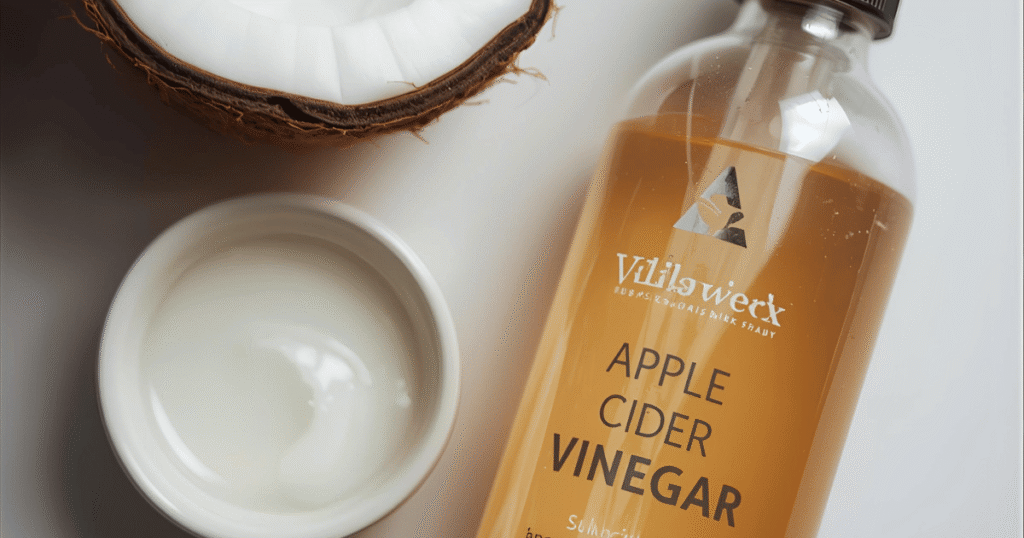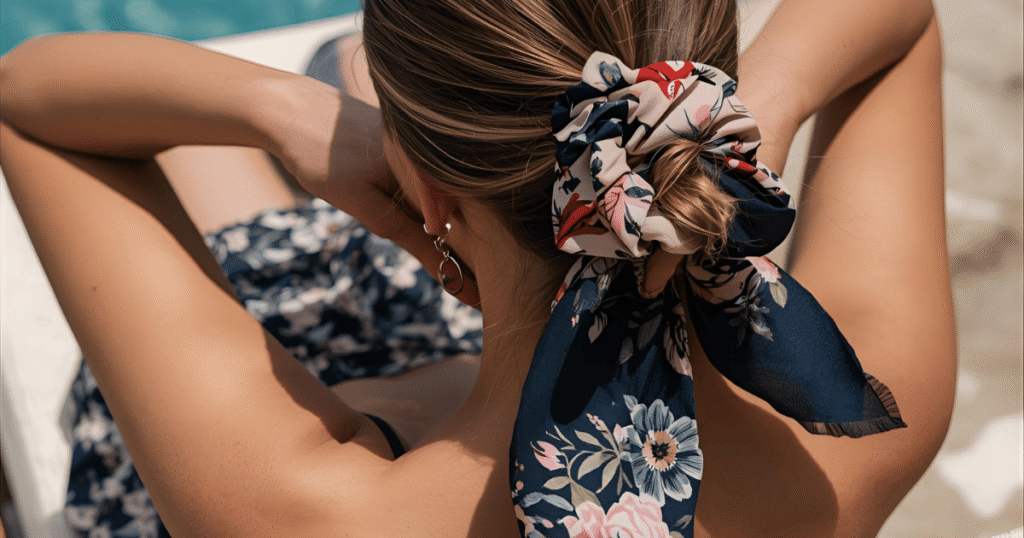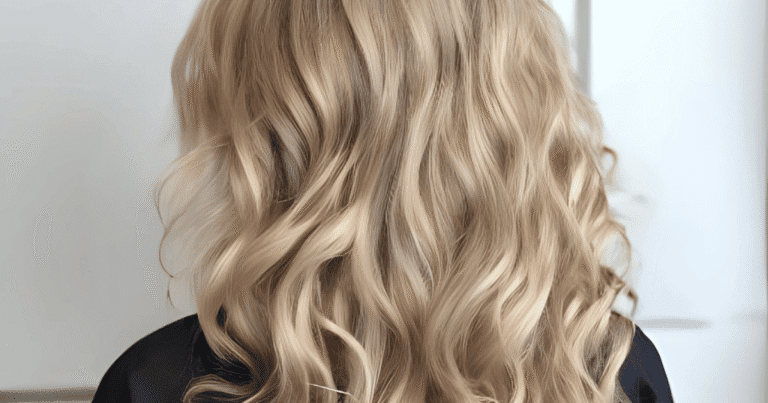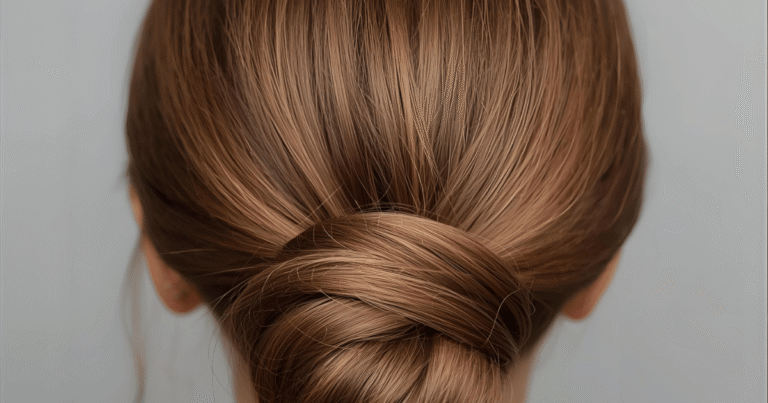Here’s a confession: I used to think green-tinged hair was simply the price of summer fun.
My daughters would spend June through August living in the pool, and by Labor Day, my blonde daughter’s hair had taken on a distinctly swamp-creature hue, while my brunettes complained of ends that felt like straw. I’d shrug, book haircuts to remove the damage, and figure this was just how summer worked.
Then I learned the science behind what chlorine and saltwater actually do to hair, and more importantly, what prevents it. Turns out, damaged summer hair isn’t inevitable. It’s just what happens when we don’t know better.
Now I know better. And after reading this guide, you will too.
What Chlorine Actually Does to Hair
Let’s start with understanding the enemy. Chlorine is added to pools for an excellent reason: it kills bacteria and keeps swimming safe. Unfortunately, it’s not particularly discriminating about what else it attacks.
It strips natural oils. Your scalp produces sebum, a natural oil that coats and protects each hair strand. Chlorine dissolves this protective layer, leaving hair exposed and vulnerable.
It opens the hair cuticle. Healthy hair has a smooth, closed cuticle (think shingles lying flat on a roof). Chlorine forces these cuticles open, which is why chlorine-exposed hair feels rough and tangles easily.
It causes oxidation. Here’s where that green tint comes from. It’s not actually the chlorine itself but the copper and other minerals present in pool water. Chlorine oxidizes these minerals, and they bond to the hair shaft. Blonde and light-colored hair shows this most dramatically, but all hair types absorb these deposits.
It weakens the hair structure. Over time, repeated chlorine exposure breaks down the proteins that give hair its strength. The result? Brittle strands prone to breakage, split ends, and that dreaded “straw” texture.
What Saltwater Does (It’s Different)
Ocean swimming presents different challenges, though the end result can be similar.
It dehydrates. Salt draws moisture out of hair through osmosis. If you’ve ever noticed your hair feeling stiff and crunchy after ocean swimming, that’s the salt literally pulling water from each strand.
It raises the pH. Healthy hair thrives at a slightly acidic pH. Ocean water is alkaline, which disrupts this balance and contributes to cuticle damage.
But there’s a silver lining. The minerals in saltwater can add natural texture and volume. This is why “beach waves” are so coveted. The trick is getting the benefits without the damage, which requires proper care before and after.

The Pre-Swim Protection Protocol
The single most effective thing you can do for summer hair happens before you ever get in the water. These steps take less than five minutes and prevent the majority of chlorine and salt damage.
Step 1: Saturate with Fresh Water
This is the foundation of pre-swim hair protection, and it’s beautifully simple.
Hair acts like a sponge. If you soak it with clean, fresh water before entering the pool or ocean, it absorbs that clean water first. Once saturated, it physically cannot absorb as much chlorinated or salty water.
Stand under the outdoor shower or rinse station at the pool. Wet your hair thoroughly from roots to ends. Don’t just dampen it; really soak it. This one step alone makes a significant difference.
Step 2: Apply a Protective Barrier
For even more protection, apply a barrier product after wetting your hair. Several options work well:
Coconut oil is a favorite natural option. It penetrates the hair shaft and creates a water-resistant coating. Apply a small amount (you don’t need much) and work it through, focusing on mid-lengths and ends. The oil literally repels water, keeping chlorine and salt from penetrating as deeply.
Leave-in conditioner works similarly. Choose a silicone-based formula for maximum water resistance, or a natural option if you prefer to avoid silicones. Apply generously.
Dedicated swim sprays are available if you prefer a product specifically formulated for this purpose. Look for options containing antioxidants to combat chlorine’s oxidizing effects.
Step 3: Cover When Possible
A swim cap won’t keep hair bone-dry (water always finds a way), but it dramatically reduces exposure. For serious swimmers or those doing daily laps, a cap is worth the mild inconvenience.
For casual pool days, consider keeping hair up and out of the water when possible. A high bun or topknot stays mostly dry during lounging and playing, even if it gets splashed occasionally.
Step 4: Protect from UV
Chlorine and salt aren’t the only summer hair threats. UV rays break down hair proteins and fade color (both natural and dyed). On pool days, consider:
A wide-brimmed sun hat during lounging time.
A UV-protecting hair spray or leave-in product.
Simply keeping hair covered or shaded when not actively swimming.

The Post-Swim Recovery Routine
What you do immediately after swimming matters almost as much as pre-swim preparation. The goal is to remove chemicals and salt before they have time to cause lasting damage.
Rinse Immediately
The moment you’re done swimming, rinse your hair with fresh water. Thoroughly. The sooner you remove chlorine and salt residue, the less damage occurs.
Don’t wait until you get home. Use the pool shower, the beach rinse station, or even a bottle of water you brought along. Time matters here.
Cleanse Properly
Within a few hours of swimming (ideally as soon as you’re home), wash your hair with a gentle cleanser. But not just any shampoo.
For regular swimmers (more than once weekly), invest in a swimmer’s shampoo or clarifying shampoo specifically designed to remove chlorine deposits and mineral buildup. Products containing EDTA or vitamin C effectively neutralize chlorine. Look for formulas that clarify without over-stripping.
For occasional swimmers, a regular clarifying shampoo used once weekly handles most buildup. The rest of the time, your normal gentle shampoo is fine.
A natural alternative: An apple cider vinegar rinse (1 part ACV to 3 parts water) effectively removes chlorine residue and restores hair’s natural pH balance. Pour through hair after shampooing, let sit for a minute or two, then rinse thoroughly.
Deep Condition Like You Mean It
Chlorine and salt both strip moisture. You must put it back.
After swimming days, follow your shampoo with a rich conditioner, focusing on mid-lengths and ends. Leave it on longer than usual (two to three minutes minimum) to allow deeper penetration.
Once weekly, use a deep conditioning mask or treatment. Apply to damp hair, leave on for at least fifteen minutes (or longer for significantly damaged hair), then rinse. This intensive moisture restoration counteracts the drying effects of pool and ocean exposure.
Seal and Protect
After conditioning, while hair is still damp, apply a leave-in conditioner or a few drops of natural oil to your ends. This seals the cuticle and locks in the moisture you just restored.
Argan oil, coconut oil, and jojoba oil all work beautifully. You need just a small amount; start with a dime-sized portion and add more only if needed.

The Weekly Deep Treatment
For swimmers, a weekly intensive treatment makes a noticeable difference in hair health throughout the summer.
DIY Moisture Mask:
- 2 tablespoons coconut oil
- 1 tablespoon honey
- 1 egg yolk (for protein)
Mix ingredients, apply to damp hair from roots to ends, cover with a shower cap, and leave on for 30 minutes to an hour. Shampoo out thoroughly (you may need to wash twice to remove all the oil).
Store-bought option: Look for masks containing keratin (to repair protein damage), natural oils (for moisture), and antioxidants (to combat oxidative damage from chlorine).
Special Situations
Blonde Hair (Natural or Colored)
Blonde hair shows chlorine damage most dramatically because it’s porous enough to absorb those oxidized minerals readily. If your daughter has blonde hair:
Be extra diligent about pre-swim saturation and barrier products.
Use a purple or violet toning shampoo once weekly to counteract any green or brassy tones that develop.
Consider a chelating shampoo (different from clarifying; it specifically removes mineral deposits) if green tinting occurs despite precautions.
Color-Treated Hair
Hair that’s been colored is already more porous and vulnerable. Chlorine fades color and can cause unpredictable shifts in tone.
Wait at least one week after coloring before swimming.
Be religious about pre-swim protection.
Use color-safe clarifying products only.
Talk to your colorist about professional treatments that can add a protective layer before heavy swim season.
Curly and Textured Hair
Curly hair is naturally drier and more prone to damage because the curl pattern makes it harder for natural oils to travel down the shaft. Chlorine and salt can be particularly harsh.
Pre-swim conditioning is essential, not optional.
After swimming, use a gentle co-wash (conditioner-only wash) instead of shampoo when possible.
Deep condition more frequently (twice weekly during heavy swim season).
Avoid brushing curly hair when dry; detangle only when wet and coated with conditioner.
Fine Hair
Fine hair can become weighed down by heavy protective oils and conditioning treatments. Adjust by:
Using lighter oils (argan or jojoba rather than coconut).
Applying conditioner only to ends, never roots.
Choosing lightweight leave-in sprays rather than creams.
Summer Styling Solutions
Here’s a practical consideration: you’ve just protected and conditioned your hair, and now you need it to look presentable at the pool party, beach barbecue, or family gathering. Heat styling seems counterproductive when hair is already stressed.
Enter the heat-free summer style.
The Protective Braid: A simple braid keeps hair contained and protected during water activities. Bonus: when you take it out, you’ll have pretty waves without any heat damage.
The Sleek Low Bun: Professional, put-together, and keeps most of your hair out of the water during casual pool time. Our bun covers work beautifully here, adding elegance while the flat design allows for comfortable lounging.
The Top Knot: High on the head, out of the water, casually chic. Secure with a scrunchie rather than elastic to avoid additional stress on chlorine-exposed hair.
The Scarf Wrap: A silk or satin scarf protects hair from sun and disguises the inevitable post-swim texture. Retro, glamorous, and entirely practical.

Building Your Summer Hair Care Kit
Keep these essentials poolside or in your beach bag:
Swimmer’s shampoo (for home use after swimming)
Spray bottle of fresh water (for pre-swim saturation when showers aren’t available)
Travel-sized leave-in conditioner or coconut oil
Wide-tooth comb (for gentle detangling when wet)
Scrunchie or soft hair tie (for protective styles)
Sun hat or scarf (for UV protection during non-swimming time)
A Final Word
Summer should be about freedom and fun, not anxiety over hair damage. With the right preparation and care, your daughters can swim to their hearts’ content without sacrificing their beautiful hair.
The key is consistency. Pre-swim protection, post-swim care, and weekly treatments work together to maintain hair health all season long. It becomes routine quickly, and the results speak for themselves.
May your summer be full of pool days, beach trips, and hair that looks as healthy in September as it did in June.
What’s your biggest summer hair challenge? Share in the comments, and let’s troubleshoot together!
Related Posts:
Heat-Free Summer Hairstyles




